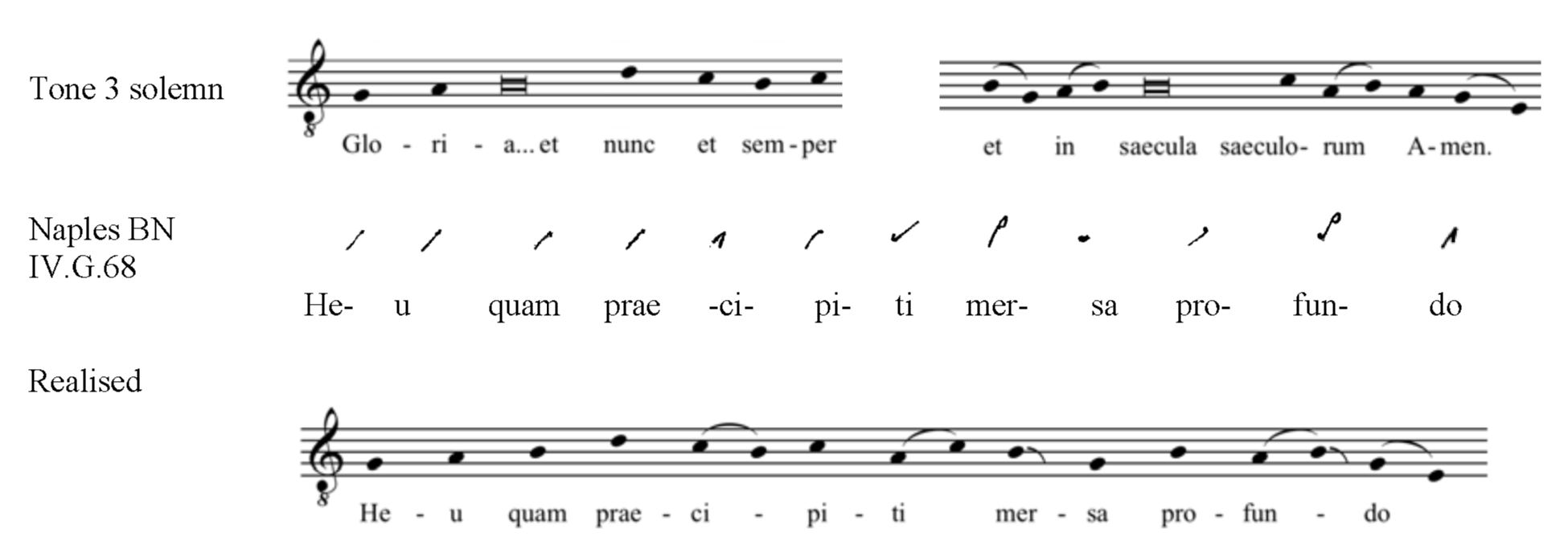A pdf version of this explanation may be dowloaded here.
The second song in the De consolatione philosophiae is sung by Philosophia, who laments Boethius’ fallen state and sternly exhorts him to begin the process of returning to his right mind. Each line of the poetic text is divided into two parts divided by a fixed caesura after the seventh syllable. The first part consists of what may be described as two and a half dactylic feet, a pattern familiar from the opening of a dactylic hexameter. The second part features an Adonic, whose metrical pattern of a dactyl followed by a long and then either a short or long syllable is routinely found as the final two feet of a dactylic hexameter line.
The wider notated tradition provides a way into understanding the relatively elaborate melody notated in the Cambridge leaf. The profile of a melody recorded for Heu quam praecipiti in the late ninth or early tenth century at the Abbey of Sankt Gallen (Naples, Biblioteca Nazionale IV. 68) accords with a solemn Tone 3 as recorded in the early tenth-century treatise Commemoratio brevis.[1]
The melodic profile of the opening of the first notated line in the mid eleventh-century Cambridge leaf corresponds with a more elaborate Tone 3 as used for Responsory Verses. In the first half of the line, there is a particularly close correspondence between the profile of the notated melody for Heu quam praecipiti in the Cambridge leaf and the Responsory Verse Tone 3 as found in the Sarum repertory, i.e. the version of plainchant associated with Salisbury Cathedral that spread rapidly across England during the Middle Ages.[2]
Formulaic phrases used in the Responds of mode 3 Responsories in the Sarum repertory provide further guidance for realizing the remainder of the melody. Decisions as to which responsorial phrases to follow as models were guided not only by proximity in profile, but also by customary sequences of phrases in the repertory.[3] Further information provided by the neumatic notation also acted as a guide, especially the pattern of repetition in the neumatic notation; for example, the pattern of neumes from line 4 quotiens to the end echoes line 1 praecipiti into line 2. Another important criterion in guiding realization was melodic grammar. Aside from following characteristic procedures, a series of decisions was made about matching the pitches of cadences to punctuation according to degrees of melodic closure and textual punctuation.
The reconstructed melody proposed here was prepared in conjunction with Benjamin Bagby and Hanna Marti, who collaborated in a series of creative practical experiments. The melody was expanded beyond the notation provided for the opening ten lines by variously repeating and excising lines within the first strophic unit of five lines, paying particular attention to match degrees of closure and cadence in text and melody wherever possible; in particular, the implications of punctuation and syntax were followed to begin new strophes in lines 15, 20 and 24. An expanded version of the explanation above was first published in Barrett, ‘Creative Practice’, pp. 274-79.
[1] Commemoratio brevis, ed. and trans. Bailey, p. 37.
[2] Walter H. Frere, Antiphonale Sarisburiense: A Reproduction in Facsimile of a Manuscript of the Thirteenth Century, with a Dissertation and Analytical Index, 3 vols. London: Plainsong and Mediæval Music Society Publication, 1901–15, vol. 1, pp. 29–32.
[3] For a full account of the phrases taken from Tone 3 Sarum Responsories, see Barrett, ‘Creative Practice’, pp. 276-9.




